Pokeweed berries and greens are a nutritional powerhouse with medicinal properties—but they can be poisonous. Here’s how to eat and use them safely.
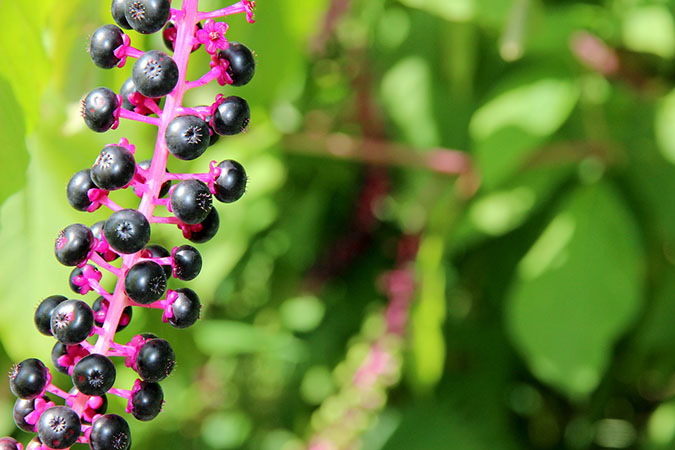
American pokeweed is a nutritional powerhouse with medicinal properties, but it must be treated with caution. (Image by efes from Pixabay)
Pokeweed Berries and Greens: Eat Up and Stay Safe
American pokeweed (Phytolacca americana) is a milestone plant for many foragers. It’s the first plant that many of us eat that could also kill us.
Don’t get me wrong. Correctly used, pokeweed berries and greens are absolutely safe. They are also highly nutritious and delicious.
This article on American pokeweed is part of a series on weed gardens and identifying and using the plants you’ll often find there. For other articles in the series, please click here.
But it’s a rare person who doesn’t feel at least a little trepidation when cooking and/or eating them for the first time.
Is Pokeweed Poisonous to Touch?
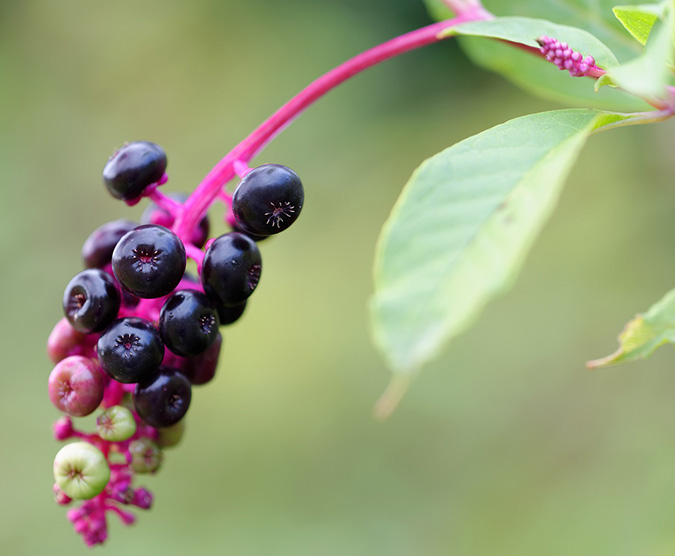
Image by Sandor Molnar from Pixabay
So, is pokeweed poisonous to touch? Considering that I painted with pokeweed berries when I was a child, the answer is no. However, as I’ll explain later, different people do have different sensitivities. So it’s always prudent to proceed with caution.
Pokeweed can indeed be dangerous if eaten improperly. On this note, my most vivid memory of pokeweed isn’t the smell coming from the boiling pot in my grandmother’s kitchen. It was much more recent.
A Scary Experience With Pokeweed Berries
A few years ago, our (then) 2-year-old came up to me with a big, purple-stained grin on his face. “Have you been eating elderberries again?” I asked him. He shook his head and led me to a tall pokeweed plant.
I saw that poke berries were missing. Lots of them. One of us might have said a swear word. I’ll let you guess who.
You May Also Enjoy:
“How to Eat Acorns: The Absolute Easiest Way”
It’s funny how panic will totally wreck your ability to think. My mind was racing to recall everything I knew about poke berries, but all I was getting was the word “poison.” I took several slow, deep breaths to calm myself.
Gradually, my brain started to work again. The berry is the least poisonous part of the plant. The juice from the berry is safe.
The Seeds of Poke Berries Are the Problem
It’s the seed that’s poisonous.1) http://www.eattheweeds.com/can-be-deadly-but-oh-so-delicious-pokeweed-2 But the seeds are designed to pass safely through the digestive tract so that the plant can spread.
Unless my son had chewed up the seeds, any poisons would likely remain safely locked away. And at this age, our boy was more of a gulper than a chewer.
You May Also Enjoy:
“Oatstraw Benefits: Stress Reliever, Love Potion, Brain Booster, and More”
My wife and I decided to wait and see if any symptoms developed. As it turned out, he was fine. He never had any problems with the poke berries at all. That day, two things happened:
- I cut down all of the pokeweed plants in our yard.
- I became skeptical of the oft-repeated claims of 10 berries (or even 1 berry2)The Essential Herb-Drug-Vitamin Interaction Guide: The Safe Way to Use Medication and Supplements Together. George T. Grossberg M.D., and Barry Fox. Publisher: Harmony. 2008.) being enough to poison a child.
Is There a Lethal Dosage of Pokeweed Berries?
One study tried to determine the lethal dose of poke berries for mice. What the researchers found was that it was impossible to give the mice a large enough dose to kill them.
After three doses, one per hour, of as much as the mice’s bellies could hold, some finally died. The equivalent amount for an adult male human would be about 45 pounds (20 kilograms).3)http://digital.library.okstate.edu/oas/oas_pdf/v43/p54_57.pdf Just for the record, 45 pounds of water would also kill an adult male human.4)http://www.nleomf.org/officers/search/search-results/james-c-mcbride.html
Of course, I wouldn’t recommend you eat a big bowlful of the berries. After all, humans may not be very much like mice. But this study does give credence to some people’s claims of actually having eaten poke berry pie.
Let’s Eat Some Pokeweed!
Our grandparents would have thought all this caution and fear were far overblown. For them, pokeweed was a mundane food—a staple of spring.
But at some point, that familiarity with our wild, native plants began to dwindle, and pokeweed became something of a daredevil food for aspiring foragers.
Let’s take back our horticultural heritage and eat some pokeweed (after preparing it correctly, of course).
Identifying the Pokeweed Plant
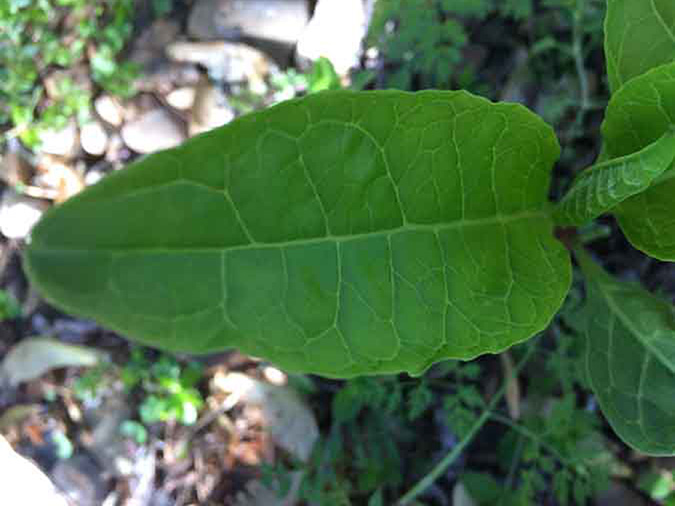
A close-up view of an American pokeweed leaf is required to correctly identify it.
Adult plants are the easiest to identify, so let’s start there. Mature American pokeweed (also called poke berry) stands 5–10 feet (1.5–3 meters) tall.
The leaves are alternate,5)Alternate: A leaf pattern in which leaves grow back and forth or in a spiraling pattern on a stem. large (4–10 inches or 10–25 centimeters long), toothless, oval- or lance-shaped, fairly succulent, somewhat wavy along the edges, and prominently veined. They also make a neat, rubbery sound when you rub a handful of them together.
The flowers are white, pink, or green. They grow on a pink stem and form a drooping, finger-shaped cluster. Flowers appear in spring through summer and turn into glossy, deep purple-to-black berries toward the end of summer and into fall.
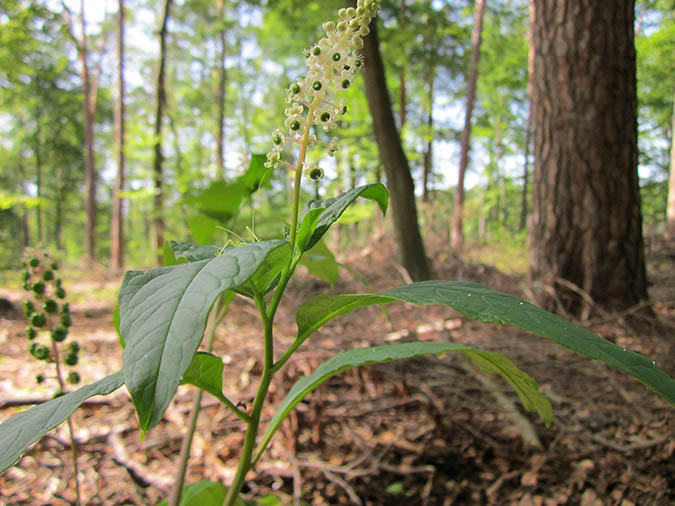
Image by WikimediaImages from Pixabay
Pokeweed berries are about the size of a pea and are flattened at the top and bottom. A mature American pokeweed stem is red or magenta (darker near the base) and has a mostly hollow core. Pokeweed has a perennial root, with the above-ground parts dying back every winter.
The dead stalks can remain through the winter and are one of the easiest ways for beginners to safely ID young plants. Mark the location of a dead stalk, and come back in the spring to harvest the new stalks growing where it stood.
Once you do this several times, you’ll start to recognize the young leaves by sight even without the older stalks to give them away.
Pokeweed Berries Have Look-Alikes
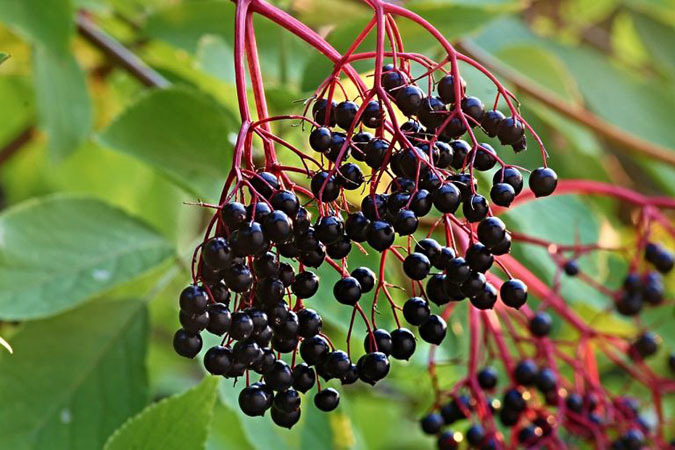
American pokeweed may be confused with elderberry, but elderberry doesn’t have alternate leaves, and its berries grow in an umbel. (Image by Manfred Richter from Pixabay)
Overall, the mature plant is very easy to identify, though it might be confused with elderberry. Elderberry does not have alternate leaves, however, and its berries grow in an umbel,6)Umbel: A flat, disk-shaped or umbrella-shaped cluster of flowers rather than a spike.
Poke berry clusters can resemble wild cherries, though cherries don’t have that garish stem color, their leaves are toothed, and they grow on a tree.
You May Also Enjoy:
“Foraging for Wild Grapes (+My Old Family Recipe for Grape Hull Preserves!)”
“The Grapes of Youth: 11+ Age-Defying Reasons to Love This Plant”
Some people say that American pokeweed is a grape look-alike. I don’t see it, myself. But if you’re having trouble, remember that grapes grow on a vine. American pokeweed does not.
Where to Find Pokeweed
Pokeweed is native to the United States. It grows throughout most of the contiguous states, except for in the Rocky Mountain states and North and South Dakota.
Pokeweed is also found in the eastern provinces of Canada and has been naturalized in the Mediterranean region. It prefers damp woodlands and open areas.
Birds help spread the seeds in their droppings. That’s why you can often find pokeweed shoots beneath popular perches. Try fence rows as well.
Harvesting Pokeweed Berries and Greens
The conventional wisdom is to harvest leaves and stems from young plants no more than 6-10 inches (15-25 centimeters) tall.7)Peterson Field Guides. Edible Wild Plants: Eastern/Central North America. Lee Allen Peterson.
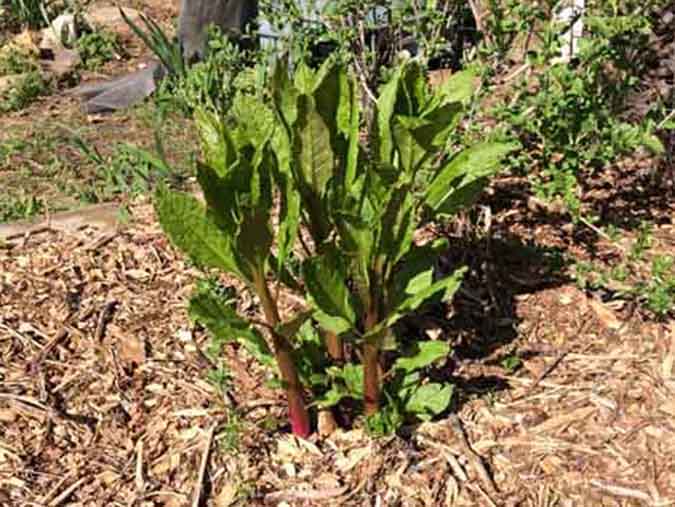
Poke berries can be harvested whenever they are ripe, from summer into fall.
I do not recommend harvesting the root as it contains the highest concentration of poison. (However, those who do opt to take the risk typically harvest the root in the fall after the main stalk has died back.)
Some people harvest from taller plants, even taking the newer growth from mature pokeweed. Depending on your level of sensitivity to the plant and your level of experience, this might or might not be a good idea.
The Pokeweed Boogeyman

Image by PublicDomainPictures from Pixabay
And this would probably be a good time to talk about the pokeweed boogeyman. In my opinion, the poisonous nature of pokeweed has been exaggerated.
People tend to repeat warnings about poisonous plants without verifying them. This can cause errors or exaggerations to be perpetuated until they assume the rank of “fact.” This seems to be what has happened with pokeweed.8)http://digital.library.okstate.edu/oas/oas_pdf/v43/p54_57.pdf
Don’t misunderstand me. Pokeweed is poisonous and has killed people. You have to respect it, and you have to use it correctly. But the level of fear exceeds the reality.9)Herbal Antibiotics, 2nd Edition: Natural Alternatives for Treating Drug-resistant Bacteria. Stephen Harrod Buhner. Storey Publishing, LLC. 2012.
To further muddy the waters, some people are more sensitive to the toxins in pokeweed than others. For example:
- The plant juice causes dermatitis in some people (like my wife) and not in others (like me).
- Some people get a stomachache if they boil the leaves only once, while others may have no ill effects.
- I’ve even seen a man claim that he saved the cooking water for use in soups. That one’s a bit much for me, but you can see how the claims of pokeweed’s relative toxicity might get confused.
A Common-Sense Caution
So what’s a forager to do?
Go slowly. Just cook a little bit your first time, and use one of the longer boiling methods described below. The next time, you can cook more.
Use your own wisdom, listen to your body, and don’t do anything that makes you feel uncomfortable. In all likelihood, you’ll be fixin’ a big mess of greens in no time.
Culinary Uses: Cooking and Eating Pokeweed Greens
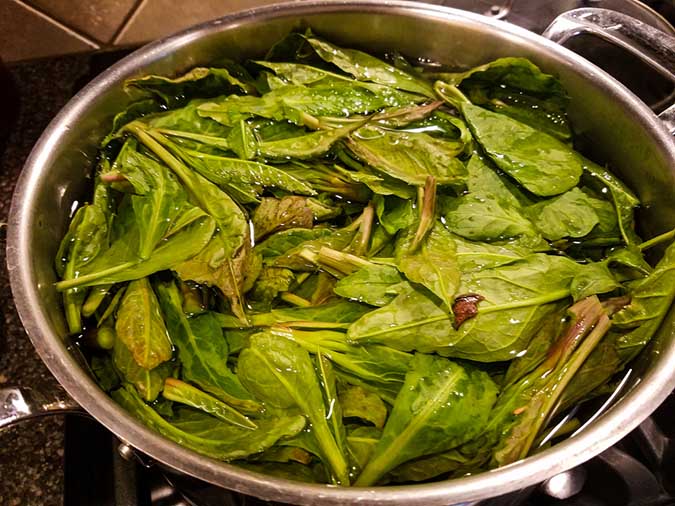
American pokeweed leaves need to be boiled before they’re eaten.
Nutritionally, pokeweed is a powerhouse plant. It’s a dynamite source of vitamins A and C and also a good source of calcium and iron.10)http://www.eattheweeds.com/can-be-deadly-but-oh-so-delicious-pokeweed-2
But how do you get to that nutrition without poisoning yourself? Poke leaves are boiled before eating.
How to Boil Pokeberry Leaves As a Tasty Meal
Opinions differ as to how long they must be boiled and in how many changes of water. This is how I do it:
- Boil the leaves for 1 minute.
- Pour out the water, and bring new water to a boil.
- Now boil the leaves for another full minute.
- Change out the water, and boil for 15 minutes.
The whole process looks like this: Boil 1 minute –> Change water –> Boil 1 minute –> Change water –> Boil 15 minutes
Remember, your timer doesn’t start until the water reaches a full boil. You can keep a second pot of water boiling so that you don’t have to wait for the water to heat up every time. If you want to err on the cautious side, you can always boil it longer.
Two boils of 15 minutes each or three boils of 10 minutes each are common cooking protocols.
Serving Up Savory Greens
Serve with salt, pepper, and butter. Some people like to add vinegar or olive oil as well.
I like to add a pinch of brown sugar. My way isn’t the healthiest, but it gets the kids to eat it. Another popular option is to toss the cooked pokeweed into a pan and scramble it with eggs. I like to add barbecue sauce. (Try it, then tell me if I’m crazy!)
You May Also Enjoy:
“Mustard Greens: What You Need to Know Before You Grow (With Recipe)”
“Grow Microgreens and Sprouts Indoors All Winter Long (Video)”
Young shoots can be peeled, breaded in cornmeal, and fried. Some people boil them first, but many (including me) don’t. Another option is to boil and then pickle the stalks. I’ve never tried this one, but it sounds tasty.
Medicinal Uses: Properties and Contraindications
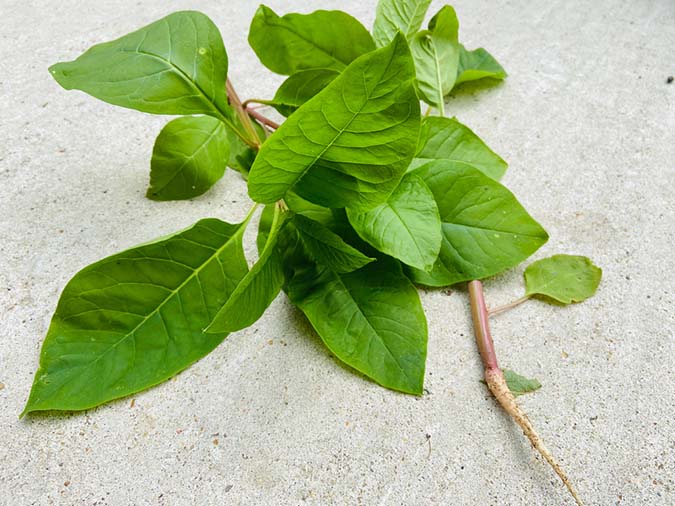
The root is the most poisonous part of the American pokeweed plant.
Used correctly, pokeweed is a powerful medicinal plant. However, the margins of safety are smaller than with most popular herbs.
The berry is the safest part of the plant to use medicinally. The root, while a very powerful medicine, is also the most poisonous.
Use caution, and get in touch with an experienced herbalist before experimenting with it yourself. Pokeweed has a wide variety of medicinal uses, both traditional and modern. Most of these likely stem from its antiviral, lymphatic, and anti-inflammatory properties.
Pokeweed Properties
Pokeweed has terrifically potent antiviral properties against a wide range of viruses, including SARS and coronavirus. It is a powerful lymphatic-system stimulant, helping to prevent cytokine storms.11)Cytokine Storm: A potentially fatal, hyper-inflammatory immune response often linked to certain viruses. Isolated compounds from the pokeweed plant have even been used to inactivate the HIV virus in rats, rendering them HIV-negative.12)Herbal Antivirals: Natural Remedies for Emerging & Resistant Viral Infections. Stephen Harrod Buhner. Storey Publishing, LLC. 2013.
That’s a lot of antiviral potential.
Pokeweed is also strongly anti-inflammatory and has a long history as an arthritis herb.13)Encyclopedia of Herbal Medicine: The Definitive Home Reference Guide to 550 Key Herbs with all their Uses as Remedies for Common Ailments. Andrew Chevallier. DK Adult. 2000. Some people take 1 berry a day to ease their symptoms. Others use the root in powder or tincture14)Tincture: A preparation in herbal medicine wherein the medicinal components of a plant are pulled into a solution of alcohol, vinegar, or glycerin and administered by dropper. form.
One suggested dose of root powder is 60–100 milligrams.15)The Essential Herb-Drug-Vitamin Interaction Guide: The Safe Way to Use Medication and Supplements Together. George T. Grossberg M.D., and Barry Fox. Publisher: Harmony. 2008. A 1:5 tincture of the dried root in 50% alcohol has also been suggested with a dose of 5–15 drops up to 3 times a day.16)Herbal Antibiotics, 2nd Edition: Natural Alternatives for Treating Drug-resistant Bacteria. Stephen Harrod Buhner. Storey Publishing, LLC. 2012. Again, use caution and seek a trained expert before putting any of this into your body.
Pokeweed Contraindications
American pokeweed has the potential to interact with drugs that have sedative properties. Possible side effects include lowered blood pressure, confusion, weakness, blurred vision, nausea, difficulty breathing, and death.17)The Essential Herb-Drug-Vitamin Interaction Guide: The Safe Way to Use Medication and Supplements Together. George T. Grossberg M.D., and Barry Fox. Publisher: Harmony. 2008.
Pregnant women should not use pokeweed.18)Encyclopedia of Herbal Medicine: The Definitive Home Reference Guide to 550 Key Herbs with all their Uses as Remedies for Common Ailments. Andrew Chevallier. DK Adult. 2000. If you’re looking for similar effects from safer plants, try skullcap or cleavers as alternatives.19)Herbal Antivirals: Natural Remedies for Emerging & Resistant Viral Infections. Stephen Harrod Buhner. Storey Publishing, LLC. 2013. Red root also has some similar properties, though it has safety issues as well.
You May Also Enjoy:
“10 Incredibly Powerful Antiviral Herbs”
Hopefully, I’ve scared you just the right amount—not so much that I scared you away, but not so little that you jump in with abandon. Pokeweed is a powerful, nutritious, delicious plant that is safe when it’s given proper respect and dangerous when it’s not.
What Do You Think?
What are your experiences with pokeweed berries and greens? Are you still asking, “Is pokeweed poisonous to touch?” Or is it now, “Pass the poke berries, please!” Have you ever tried poke berry pie and lived to tell the tale? I’d love to hear all about it in the comments.
____________________
Psst! Our Lawyer Wants You to Read This Big, Bad Medical Disclaimer –> The contents of this article, made available via The Grow Network (TGN), are for informational purposes only and do not constitute medical advice; the Content is not intended to be a substitute for professional medical advice, diagnosis, or treatment. Always seek the advice of a qualified health care provider with any questions you may have regarding a medical condition. If you think you may be suffering from any medical condition, you should seek immediate medical attention. You should never delay seeking medical advice, disregard medical advice, or discontinue medical treatment because of information provided by TGN. Reliance on any information provided by this article is solely at your own risk. And, of course, never eat a wild plant without first checking with a local expert.
The Grow Network is a participant in the Amazon Services LLC Associates Program, an affiliate program designed to provide a means for our team to earn fees for recommending our favorite products! We may earn a small commission, at no additional cost to you, should you purchase an item after clicking one of our links. Thanks for supporting TGN!

Scott Sexton is a TGN Trailblazer, a highly experimental gardener, an unrelenting weed-eater, and a largely non-profit herbalist (much to his wife’s chagrin). When Scott is not teaching foraging classes, testing out theories in the garden, or grazing in the forest, he can be found at his Facebook page, “A Forager’s Guide to the Zombie Apocalypse.”
References
| ↑1 | http://www.eattheweeds.com/can-be-deadly-but-oh-so-delicious-pokeweed-2 |
|---|---|
| ↑2 | The Essential Herb-Drug-Vitamin Interaction Guide: The Safe Way to Use Medication and Supplements Together. George T. Grossberg M.D., and Barry Fox. Publisher: Harmony. 2008. |
| ↑3, ↑8 | http://digital.library.okstate.edu/oas/oas_pdf/v43/p54_57.pdf |
| ↑4 | http://www.nleomf.org/officers/search/search-results/james-c-mcbride.html |
| ↑5 | Alternate: A leaf pattern in which leaves grow back and forth or in a spiraling pattern on a stem. |
| ↑6 | Umbel: A flat, disk-shaped or umbrella-shaped cluster of flowers |
| ↑7 | Peterson Field Guides. Edible Wild Plants: Eastern/Central North America. Lee Allen Peterson. |
| ↑9, ↑16 | Herbal Antibiotics, 2nd Edition: Natural Alternatives for Treating Drug-resistant Bacteria. Stephen Harrod Buhner. Storey Publishing, LLC. 2012. |
| ↑10 | http://www.eattheweeds.com/can-be-deadly-but-oh-so-delicious-pokeweed-2 |
| ↑11 | Cytokine Storm: A potentially fatal, hyper-inflammatory immune response often linked to certain viruses. |
| ↑12, ↑19 | Herbal Antivirals: Natural Remedies for Emerging & Resistant Viral Infections. Stephen Harrod Buhner. Storey Publishing, LLC. 2013. |
| ↑13, ↑18 | Encyclopedia of Herbal Medicine: The Definitive Home Reference Guide to 550 Key Herbs with all their Uses as Remedies for Common Ailments. Andrew Chevallier. DK Adult. 2000. |
| ↑14 | Tincture: A preparation in herbal medicine wherein the medicinal components of a plant are pulled into a solution of alcohol, vinegar, or glycerin and administered by dropper. |
| ↑15, ↑17 | The Essential Herb-Drug-Vitamin Interaction Guide: The Safe Way to Use Medication and Supplements Together. George T. Grossberg M.D., and Barry Fox. Publisher: Harmony. 2008. |
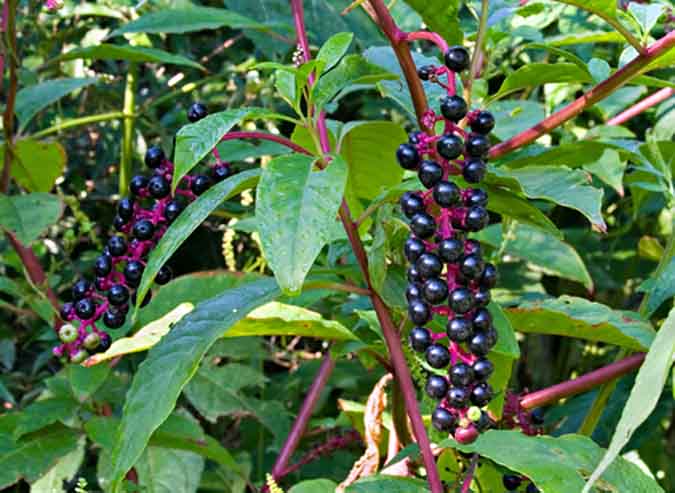







COMMENTS(4)
First are Poke greens when I was around 20, with round green pepper-vinegar (like the tobasco vinegar with hot peppers in it). It was great! I pick it for myself, always before the stem is red, double boil (about 15 minutes each) then freeze to use later. It still has a strong taste, more like Kale or older Chard than Spinach.
I try to just say, Poke greens, as a friends Mom actually made a salad of Poke, after remembering the phrase Poke salad. She was in the hospital for a while to get the poison out! So Poke greens is a better phrase.
Would like to make a Poke green pie, like the Spinach dip mix flavor, but using double boiled Poke. Think it would be a winner, especially with added cheddar shreds and pimentos in the mix. And also a slightly sweet crispy, flaky crust mix.
Non-vegans should add bacon, chicken or other meats (maybe ham?).
I wonder if you could dehydrate the berries or freeze them for medicine all year instead of just in season? I have degenerative disk disease and a connective tissue disorder that causes severe joint pain and the berries do seem to help both.
Hi Owl, Yes you can dehydrate the berries to use them all year. If you have a dehydrator, this is easy. Or you can use your oven on very low, like no more than 110 degrees, put the berries on parchment paper on a cookie sheet and leave them in the oven till dry, that’s maybe 2 hours. Check them and if they need more time, give them more time. Store them when dry, in a glass jar with a tight fitting lid and put a label on the jar stating the date and Poke Berry.